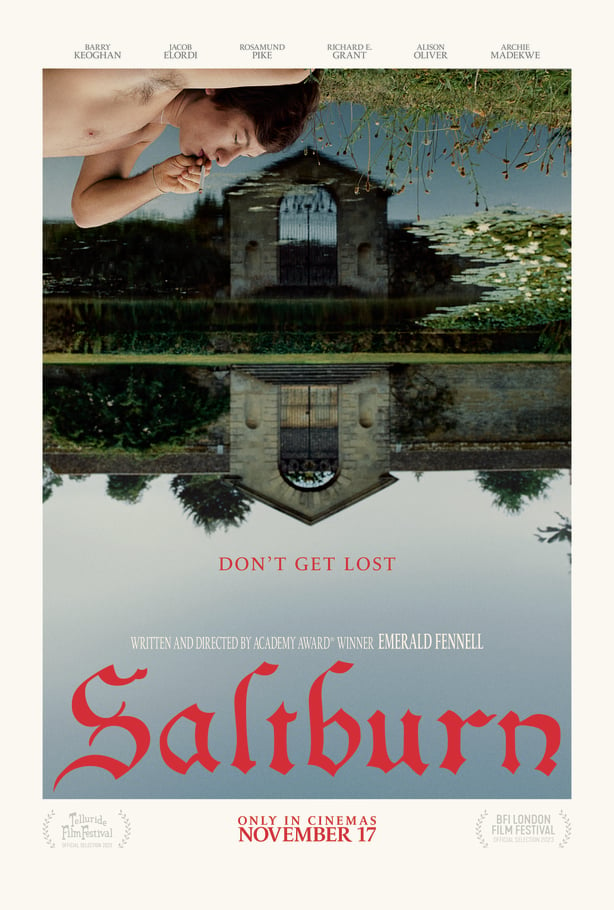Analysis: there is something obviously fascinating about Saltburn and it's not just the sight of an Irishman's backside
Warning: this article contains spoilers.
Eagerly awaited since her debut movie Promising Young Woman (2020), Emerald Fennell's second movie Saltburn (2023) has caused a lot of ink to flow. With a stellar cast - Rosamund Pike, Richard E. Grant, Jacob Elordi and national gems Barry Keoghan and Alison Oliver, to name a few - the movie sparked controversy due to a few memorable and very graphic scenes.
There is something obviously fascinating about Saltburn. While some viewers see the movie through a classist and eat-the-rich lens, others see it as an aesthetically pleasing film and clever thriller. The addition of symbolism throughout the movie has created infinite layers of interpretation in regular print and social media. An outlandish TikTok describing the similarities between Harry Potter and Saltburn theorised that the character Felix (as played by Elordi) has a hand tattoo which is a reference to Harry Potter, a theory further corroborated by the fact that Felix reads the sixth volume of the saga.
Trailer for Saltburn
But what makes Saltburn so appealing? The multiple interpretations are undeniably one factor. Perhaps some of the interest in the movie is due to the fact that it brings other artworks to mind. I could not help but notice the similarities between Saltburn and The Talented Mr Ripley (written by Patricia Highsmith in 1955 and adapted on the screen by Anthony Minghella in 1999).
Both feature mentally unstable young men who become obsessed with another man who is both richer and more handsome than them. The result of this obsession inevitably leads to the murder of the golden boy. Both main characters (Oliver in Saltburn played by Keoghan, Tom Ripley in The Talented Mr Ripley) have to compete for the attention of their idol (with Farleigh and Venetia in Saltburn, Freddy and Marge in The Talented Mr Ripley).
Both can be read as a commentary on social classes, although Saltburn is focused more on a satire of the rich than The Talented Mr Ripley. Certainly, Saltburn tries to shock more than Mr Ripley, with three scenes in particular everyone has heard of at this point. While neither Felix nor Oliver are portrayed with one ounce of empathy (unlike Ripley), there is no point denying the influence of Highsmith’s work and Minghella’s adaptation on Saltburn.

But the fascination with Saltburn is not just limited to Highsmith’s fans. In fact, Saltburn is a familiar tale with universal topics. The movie will keep you on the edge of your seat, but it also explores the ever growing interest in an outsider trying to get into a circle of rich idlers. Tales exploring this theme have led to major successes these past fifteen years on the big and little screens (Gossip Girl, The Bling Ring, Triangle of Sadness). Older and written accounts also feature this, from French go-getter Rastignac in Balzac's book series La Comedie Humaine (1829-48) to Edith Wharton's Undine Spragg in The Custom of the Country (1913). The list goes on and on.
This brings me to my initial question: what is so appealing about this tale? Arguably, it fulfils many people’s dream: infiltrating the upper class. Such a tale usually starts with the outsider’s struggles to get accepted by the high society, and using someone well-established in this circle to achieve it. Once they do, the desire to infiltrate the crème de la crème turns into wanting to be one of them permanently - here we usually find awkward scenes as it is easy to capture a rich idler’s interest, but it is not that easy to maintain their interest.
The main character then usually resorts to manipulation and seduction, one the key appealing factors for such stories. This is where extreme subterfuges are used to become one of them, such as Oliver consuming Felix and Venetia’s bodily fluids like a vampire or a parasite, both common images used as metaphors to criticise neoliberalism. Significantly, Fennell described her movie as a vampire movie.
From Vanity Fair, Saltburn director Emerald Fennell discusses the film's arrival scene
Taking from the rich and enjoying their decadence never fails to entertain. It reminds us of a rags to riches story in a way, although a rags to riches story implies hard work and sacrifice. The only sacrifice Oliver makes is his family, which he does not seem to mind as he gets an entire estate in exchange. If there is one thing to learn from Oliver’s sexual encounters in the movie, it is that desire motivates him more than anything, and whether it is desire for things or bodies does not make a difference for him.
As bodies are piling up and stones are thrown under the bridge, the movie ultimately asks: would you do it? How far would you go to fulfil your desires? Most importantly: is the feeling of dancing alone and naked in your own castle worth anything?
Oliver’s dedication in the long run is certainly admirable, and the ease with which he conducted his scheme is compelling. There is an odd sense of justice among all of the corpses, as Oliver achieves what only a few people can do: break a social hierarchy. It's up to the viewer to decide if it is worth it or not.
The views expressed here are those of the author and do not represent or reflect the views of RTÉ





